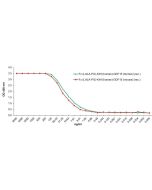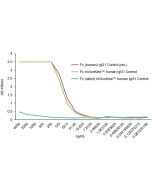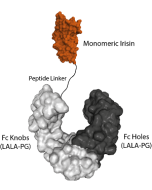Cookie Policy: This site uses cookies to improve your experience. You can find out more about our use of cookies in our Privacy Policy. By continuing to browse this site you agree to our use of cookies.
AdipoGen Life Sciences
GDF15 (mouse):Fc (silent) InVivoKine™

| Product Details | |
|---|---|
| Synonyms | Fc (LALA-PG)-KIH:Growth/Differentiation Factor 15; GDF-15; Macrophage Inhibitory Cytokine 1; MIC-1 |
| Product Type | Protein |
| Properties | |
| Source/Host | HEK 293 cells. Produced using animal component-free medium. |
| Sequence |
The extracellular domain of mouse GDF15 (aa 189-303) is fused to the C-terminus of the Fc (LALA-PG) Knob region of human IgG1. Fc (LALA-PG) Knobs:GDF15 (mouse) and Fc (LALA-PG) Holes form the GDF15 (mouse):Fc (silent) InVivoKine™ using the Knobs-into-Holes technology (see reference: J.B. Ridgway, et al.; Protein Eng. 9, 617 (1996)). |
| Crossreactivity | Mouse |
| Specificity |
Binds to mouse GFRAL. The Fc contains the mutations LALA-PG that abolish the interaction between the Fc and FcγRs and therefore Fc undesirable effects. The Fc (LALA-PG) is named Fc (silent). |
| Biological Activity |
Binds to its receptor mouse GDNF family receptor alpha-like (GFRAL) with an ED50 <15ng/ml. |
| MW | ~45kDa and 30 kDa (SDS-PAGE) |
| Purity | ≥95% (SDS-PAGE) |
| Endotoxin Content | <0.01EU/μg purified protein (LAL test). |
| Concentration | 1mg/ml after reconstitution. |
| Reconstitution | Reconstitute with 50μl endotoxin-free water. |
| Accession Number | Q9Z0J7 |
| Formulation | Lyophilized. Contains PBS |
| Protein Negative Control |
Fc (silent) InVivoKine™ human IgG1 Control (Prod. No. AG-35B-0018) |
| Other Product Data |
Note 1: Conventional GDF15-Fc fusion proteins have been shown to form aggregates, which contribute to reduced biological activity. The GDF15 InVivoKine™ developed by Adipogen is a dimeric high-activity GDF15 preparation, as demonstrated by Size Exclusion Chromatography (SEC), confirming the absence of aggregation. NCBI reference Q9Z0J7: GDF15 (mouse) |
| Shipping and Handling | |
| Shipping | BLUE ICE |
| Short Term Storage | +4°C |
| Long Term Storage | -20°C |
| Handling Advice |
Avoid freeze/thaw cycles. Centrifuge lyophilized vial before opening and reconstitution. PBS containing at least 0.1% BSA should be used for further dilutions. |
| Use/Stability |
Stable for at least 6 months after receipt when stored at -20°C. Working aliquots are stable for up to 3 months when stored at -20°C. |
| Documents | |
| MSDS |
 Download PDF Download PDF |
| Product Specification Sheet | |
| Datasheet |
 Download PDF Download PDF |
Growth and differentiation factor 15 (GDF15, also known as macrophage inhibitory cytokine-1 (MIC-1)), is a member of the transforming growth factor (TGF)-β superfamily and was initially identified in activated macrophages. GDF15 acts through a recently identified receptor called Glial-derived Neurotrophic Factor (GDNF) Receptor Alpha-Like (GFRAL) which signals through the Rearranged during Transfection (RET) tyrosine kinase receptor. GDF15 is highly expressed in placenta and brain, and it is expressed at lower levels in kidney, pancreas, prostate and colon. Similar to other TGF-β family proteins, GDF15 is synthesized as a large precursor protein that is cleaved to release the mature protein that shares 66% and 97% amino acid sequence identity with the human and rat proteins, respectively. Biologically active GDF15 is a disulfide-linked homodimer of the mature protein. The effects of GDF-15 are pleiotropic and include appetite regulation, actions on metabolism, pregnancy, cell survival, immune response and inflammation. GDF-15 also plays different roles in the pathophysiology of cardiovascular disease, autoimmunity, cancer-associated anorexia/cachexia and diabetes.
High levels of GDF15 cause anorectic effects and cachexia, largely if not exclusively through the suppression of food intake via modulation of neuropeptide Y and pro-opiomelanocortin levels. Various functions have been reported for GDF15, including inhibition of TNF-α production from lipopolysaccharide-stimulated macrophages and the induction of cartilage formation. GDF15 promotes also neuronal survival. GFRAL and GDF15 signaling is implicated in diet-based obesity and insulin resistance. GDF15 is cardioprotective via inhibition of platelet activation, limiting atherosclerosis, promoting recovery following myocardial infarction and regulating angiogenesis.
The GDF15 (mouse):Fc (silent) InVivoKine™ is produced by using two different vectors, one encoding for the Fc Knobs (LALA-PG) (human):GDF15 (mouse) sequence (synthesizing a protein of 45kDa) and one encoding for the Fc Holes (LALA-PG) sequence (synthesizing a protein of 30kDa). Both vectors transfected into HEK293 cells produce both Fc molecules (Knobs-into-Holes technology; J.B. Ridgway, et al.; Protein Eng. 9, 617 (1996)) required for dimerization and for secretion of the final protein GDF15 (mouse):Fc (silent) InVivoKine™. This Fc-KIH format allows our mouse GDF15 protein to form a dimer that is the most active structure to bind and activate the GFRAL and RET receptor complex. The LALA-PG mutations inhibit binding to FcγRs and C1q while FcRn binding and Fc stability remain unaffected.
InVivoKines™ are a new generation of recombinant fusion proteins for immunotherapeutic, preclinical and translational in vivo research, developed and manufactured by AdipoGen Life Sciences.











